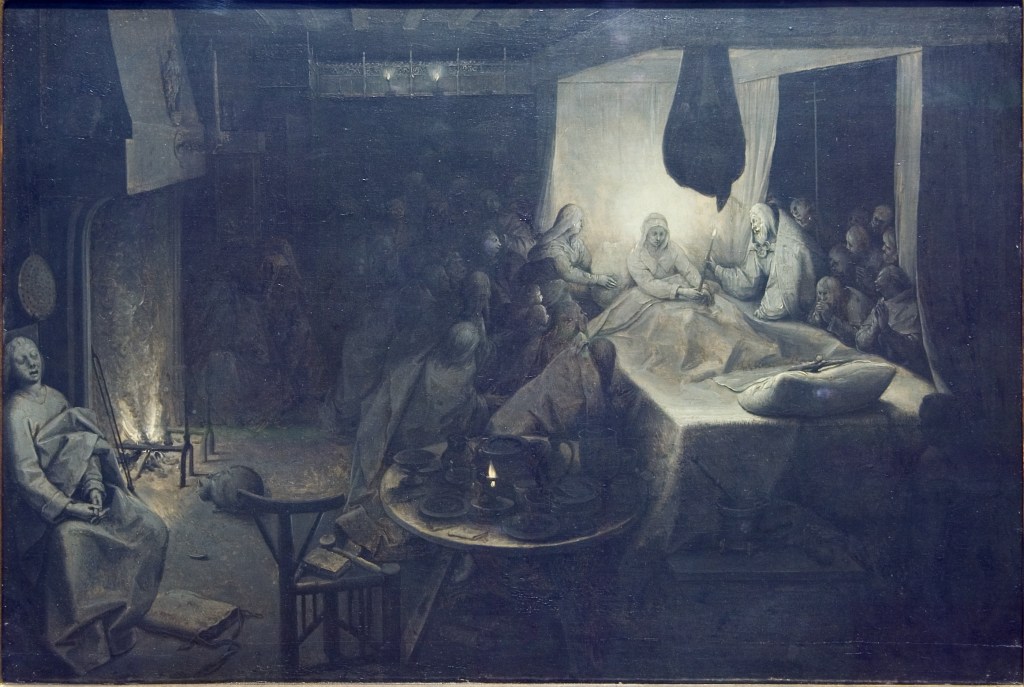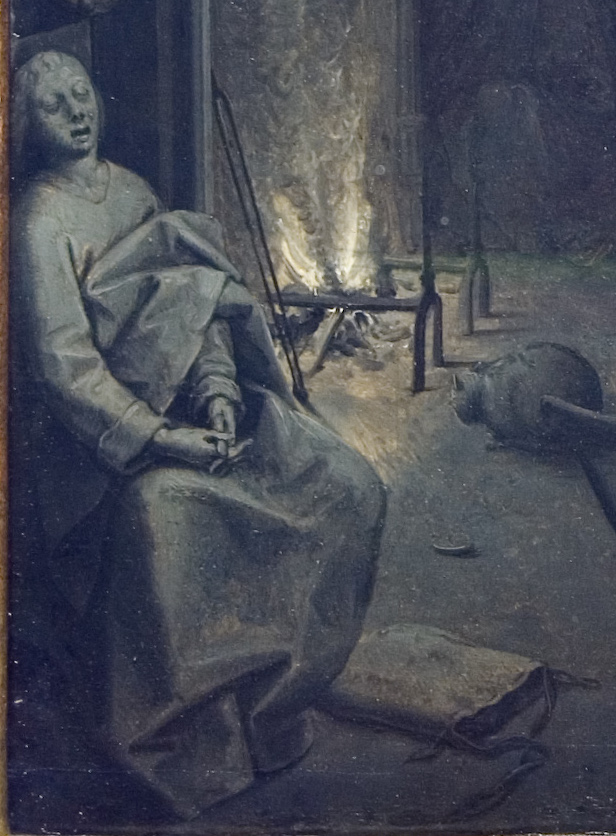

My initial idea was to write about grisaille, that strange old custom of painting without colour, using only various shades of brown, or alternatively, of grey.
But then to add to that deprivation, another one, of light, and choose painters who try to paint the dark or in the dark, at night in which colour naturally disappears, so it is no longer just an artist’s trick but rendering a large area of reality commonly cut off from painting. This could be a huge undertaking, so I narrowed it to just two paintings by two of the greatest artists, Bruegel and Rembrandt, painting almost a century apart but both using the voluntary restrictions of a colourless world to provoke viewers to more intense scrutiny, like an intelligent version of the harder looking forced on someone stuck in a dark room and becoming slowly used to the new conditions.
Wallace Stevens says somewhere that good poems defeat the efforts of intelligence almost successfully. This comes as close to an explanation of my love of obscurity in art as anything I’ve ever heard or thought.
There’s something doubly perverse in setting out to collect and write about outstanding cases of obscurity in art—to share their unrecognised beauties, yes, but also, inevitably, to clarify them and end up making them less obscure, as if—horrid conventionality—the final goal in thinking about anything were always to make something clearer. Easy to accept that poetry doesn’t usually make things clearer, but prose is different–is it really acceptable to write an essay with the aim of making something un-clear?
Certain painters, Rembrandt above all, are drawn to depicting night and darkness while at the same time telling stories. And there’s a wonderful little Bruegel that takes place at night in a large room, half of which is packed with people (the crowd in the left background) you don’t even see at first. In some sense you never see them, they are so indistinct and so inessential to the main event, the Death of the Virgin lying in bed, the main piece of furniture in a room cluttered with others, and a stray figure or two, like a young man asleep beside the fire, often mistaken for St John, who usually has an important role in this traditional scene.

The great events here are the various candles and the fire, most of them scattered rationally but also pointlessly, as far as illuminating the main event goes. The brightest candle is outshone by a light which encompasses and dwarfs it and has no visible cause, the radiance of the about-to-be corpse that critics connect with the imminent appearance of Christ, which hasn’t happened yet but is spelled out in conventional sources.

So the painting shows a supernatural event on the verge of happening, but is also entirely (almost entirely?) explicable as an episode in the story of Light, how it travels and stops just short of a certain desired goal, how it sets out bravely and that is the end of that. How the destruction of certain modest lengths of wood has the incidental effect of putting a cat to sleep and showing human onlookers a big expanse of floor, the most collected view available of the context in which the great event is going to occur.
The most enigmatic element in the whole obscure scene is one of the painter’s slyest tricks. Someone has rigged up a little theatrical display for an audience of one, or maybe two or three. At the end of Mary’s bed propped on a cushion is a very early emblem of Christ’s crucifixion, a little model of His Body on the cross.
The picture simulates eyes getting used to the dark, and that is a metaphor for something wider or more universal, the search for knowledge. The experience of deciphering (almost successfully)–which is also what we do with any work of art, obscure or not—puts lots in play, as if much remains undecided, so it becomes a testing ground for something like experimental thinking.

Rembrandt puts much more in play than Bruegel—when you look closely, the elements of this picture of Christ’s Entombment in Glasgow do not look like anything that you’ve seen in reality before.
It’s making a fresh point about itself as a fiction, and it becomes a multiple reality. It’s at least two different things at once, a set of marks and a human story, a divergence extreme enough to make a chasm in perception, provoking an excitement that waited to be rediscovered by Cezanne.
The Glasgow Entombment creates insistent doubts we don’t find it easy to settle: are we standing in, or looking across the hollow of the grave? The level area the group has gathered in seems to drop off abruptly into a dark space we can’t fathom. How big is this void? It’s impossible to tell.

I’ve just noticed today how the sensation of Christ’s weight pulling the shroud he is wrapped in down towards the earth is created – by two strong, wide, mainly black strokes drawn through and along the bottom of the pale sheet, which has a strong white highlight at its near edge, the largest area of pure white in the picture. Mary’s lap and Joseph of Arimathea’s forehead are the only other spots of white, and the forehead is markedly less intense.

Fascinating how detail begins to be lost the further you go from the centre, but it’s not as simple as that. Those to the left of Christ are less sharply defined, defined in fact by a different method, which is only partly accounted for by their being caught in the glare of the lamp or candle. The tall man behind the kneeling woman (not everyone accepts that she is Christ’s mother) is seen in almost the same register as the servant holding the shroud, who is much more clearly defined. It’s almost as if it’s our attention which determines how characters will be shown. You move in different directions, up to the right of the central group, for example, and the mode of consciousness represented by the picture changes. Fascinating too how the indistinct crowd follows an almost invisible slope – the whole subject occupies a diagonal slash caught in a more pervasive darkness. The rising trajectory of this indistinct extension is unaccountably pleasing, as are smaller tunnels of darkness behind the kneeling woman/ Mary and in front of the figure holding Christ’s feet.
 Exploring the picture is again analogous to getting used to seeing in the dark. It can be a long process, working out various relations in this composition, which intrigues us so much because it is so unclear. It’s another subject showing, like the Death of the Virgin, people gathered round a prone figure, a quintessentially static subject.
Exploring the picture is again analogous to getting used to seeing in the dark. It can be a long process, working out various relations in this composition, which intrigues us so much because it is so unclear. It’s another subject showing, like the Death of the Virgin, people gathered round a prone figure, a quintessentially static subject.
Christ has sunk to near the bottom of the space and dragged the rest with him. All the movement is downward, yet the light suggests otherwise, as if it is on the point of bursting out, and radiates upward, not downward. Magical how far left the subject has moved, the picture is radically asymmetrical, unless you see it as a light half on the left balanced by a dark half on the right, but this equality doesn’t exist. The left is far stronger, no halves.

In Bruegel’s Death of the Virgin supernatural light has created a strangely perfect little room within the room, with top and bottom defined by their corners, and clear back and side walls, the two front walls removed, and partly indicated by bunched and dangling bed curtains. Just as weirdly asymmetrical as Rembrandt’s Entombment, with a wider range of definition in things represented, among which you cautiously pick your way, as usual in Bruegel, an inventory enhanced here by the struggle with continuing gloom.
The connection between Mary and the little crucifix is at the heart of the picture, and forms the top and bottom of a larger cross, whose arms are defined in living form by Peter and the female attendant, like a deliberate mistranslation of the crucifixion subject. Christ is shown perversely lying on a comfortable bed in the form of a plump pillow. This is impressionistically rendered, with bold abbreviations (where are His hands?). As the exemplary Courtauld catalogue of 2016 points out, His feet have retreated until they are just two small blobs, the tiniest individuality paint can have. This crucifix is such a strange detail that you have a momentary fear you could have overlooked it.

If this is the threshold of a visionary moment, as some people think, then the sleeping figure may be important—what looks like a stupor is actually the disguise for a private vision, and an essential thread links the about-to-be ecstatically-raised Virgin and the young person lost in his vision, or not—could his oblivion be the dumb version of an out-of-body state, as common as sleep and at the furthest remove from the action, like a planet at the edge of its solar system?

The table and chair between him and the bed do indeed seem the impediments of an earthbound not a visionary mode. He is the furthest and not the nearest sharer of the great moment, on a par with the cat. I don’t like this interpretation, though, and would rather see him as human ordinariness getting on with daily life, harmlessly, and regardless of the earthshaking Assumption about to happen.
Pieter Bruegel the Elder, The Death of the Virgin, c 1562-65, 36.9 x 55.5 cm, Bearsted Collection, Upton House, Warwickshire (The National Trust)
Rembrandt, The Entombment Sketch, late 1630s-early 1640s, revised mid 1650s, 32.2 x 40.5 cm, The Hunterian, University of Glasgow
Curators in Glasgow have made a point of naming The Entombment a sketch and not a grisaille, because it incorporates reddish earth tones (unlike most grisailles), because it was named that way when Rembrandt had to sell it to pay his debts, because it hung for twenty years on a wall in his house and he kept reworking it (as extensive technical examination has shown). The figures on the left in the bolder mode of the 1650s are the strongest signs of the reworking, but new highlights and deletions are evident throughout. The painting is a striking instance of Rembrandt’s constant rethinking of his own ideas.

The Entombment, infrared reflectogram, showing bold black strokes defining forms
